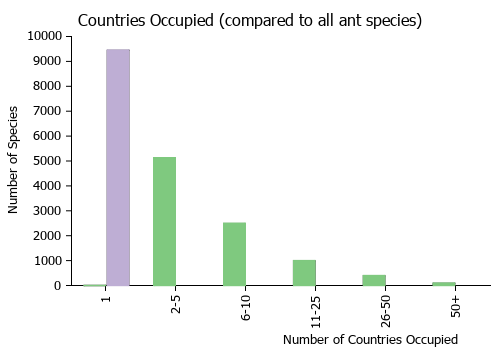Polyrhachis ugiensis
| Polyrhachis ugiensis | |
|---|---|

| |
| Scientific classification | |
| Kingdom: | Animalia |
| Phylum: | Arthropoda |
| Class: | Insecta |
| Order: | Hymenoptera |
| Family: | Formicidae |
| Subfamily: | Formicinae |
| Tribe: | Camponotini |
| Genus: | Polyrhachis |
| Subgenus: | Cyrtomyrma |
| Species: | P. ugiensis |
| Binomial name | |
| Polyrhachis ugiensis Mann, 1919 | |
Nothing is known about the biology of Polyrhachis ugiensis.
Identification
Polyrhachis ugiensis is most similar to Polyrhachis fulakora. In outline, the pronotal dorsum of Polyrhachis ugiensis is much more convex, especially anteriorly, where it rises from the pronotal collar almost vertically for a short distance and then continues in a convex outline to the promesonotal suture. In contrast, the pronotal dorsum in Polyrhachis fulakora is only weakly convex from the pronotal collar to the promesonotal suture. Also, the lateral petiolar spines in Polyrhachis ugiensis are greatly reduced, while the petiolar spines in Polyrhachis fulakora are more-or-less subequal. Both species differ from the closely allied Polyrhachis johnsoni in having the greatest width of the pronotal dorsum at, or about, the middle of its length. In Polyrhachis johnsoni the greatest width of the pronotal dorsum is across, or just below the humeri. (Kohout 2006)
Keys including this Species
Distribution
Solomon Islands.
Latitudinal Distribution Pattern
Latitudinal Range: -9.577328° to -10.444°.
| North Temperate |
North Subtropical |
Tropical | South Subtropical |
South Temperate |
- Source: AntMaps
Distribution based on Regional Taxon Lists
Indo-Australian Region: Solomon Islands (type locality).
Distribution based on AntMaps
Distribution based on AntWeb specimens
Check data from AntWeb
Countries Occupied
| Number of countries occupied by this species based on AntWiki Regional Taxon Lists. In general, fewer countries occupied indicates a narrower range, while more countries indicates a more widespread species. |

|
Estimated Abundance
| Relative abundance based on number of AntMaps records per species (this species within the purple bar). Fewer records (to the left) indicates a less abundant/encountered species while more records (to the right) indicates more abundant/encountered species. |

|
Biology
Castes
Images from AntWeb
   
| |
| Syntype of Polyrhachis ugiensis. Worker. Specimen code casent0905543. Photographer Will Ericson, uploaded by California Academy of Sciences. | Owned by MSNG, Genoa, Italy. |
Nomenclature
The following information is derived from Barry Bolton's Online Catalogue of the Ants of the World.
- ugiensis. Polyrhachis (Cyrtomyrma) rastellata subsp. ugiensis Mann, 1919: 389 (w.) SOLOMON IS. Raised to species: Donisthorpe, 1938c: 260. See also: Kohout, 2006b: 142.
Unless otherwise noted the text for the remainder of this section is reported from the publication that includes the original description.
Description
Worker
Length 5.5-6 mm.
The specimens from the eastern Solomons represent still another form of this variable species, characterized by the shorter spines of the petiole, which in some specimens have the lateral ones reduced to mere angles, and in the color of the legs. The femora and the tibiae are reddish brown, with the bases of the latter and the tarsi black. The antennae are black, except the extreme tip of the last segment, which is brown.
Type Material
Syntype workers: Museum of Comparative Zoology, Los Angeles County Museum of Natural History, Queensland Museum and National Museum of Natural History - as reported by Kohout (2006).
Type Locality Information
The material the description was based on was stated by Mann to have been collected from: SOLOMON IS, Ugi, Pawa; San Cristoval, Wai-ai, Pamua, Wainoni Bay; Three Sisters, Malapaina.
References
- Donisthorpe, H. 1938c. The subgenus Cyrtomyrma Forel of Polyrhachis Smith, and descriptions of new species, etc. Ann. Mag. Nat. Hist. 11(1): 246-267 (page 260, Raised to species)
- Kohout, R. J. 2006. Review of Polyrhachis (Cyrtomyrma) Forel (Hymenoptera: Formicidae: Formicinae) of Australia, Borneo, New Guinea and the Solomon Islands with descriptions of new species. Memoirs of the Queensland Museum. 52:87-146.
- Mann, W. M. 1919. The ants of the British Solomon Islands. Bulletin of the Museum of Comparative Zoology 63: 273-391 (page 389, worker described)
References based on Global Ant Biodiversity Informatics
- Kohout R.J. 2006. Review of Polyrhachis (Cyrtomyrma) Forel of Australia, Borneo, New Guinea and the Solomon Islands with descriptions of new species. Memoirs of the Queensland Museum 52: 87-146.
- Mann W. M. 1919. The ants of the British Solomon Islands. Bulletin of the Museum of Comparative Zoology 63:273-391.
- Mann, W.M. 1919. The ants of the British Solomon Islands. Bulletin of the Museum of Comparative Zoology of Harvard College 63: 273-391
- Wheeler W.M. 1935. Check list of the ants of Oceania. Occasional Papers of the Bernice Pauahi Bishop Museum 11(11):1-56.
- Wheeler, William Morton.1935.Checklist of the Ants of Oceania.Occasional Papers 11(11): 3-56

